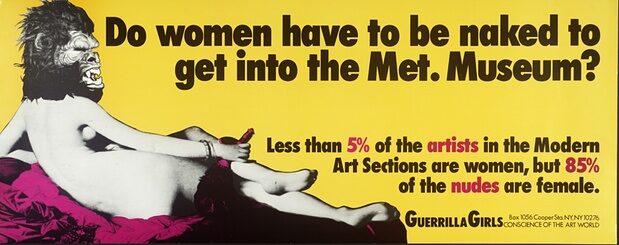
by Giulia Simi*
The future of the world is open: it lies in starting along the path from the beginning again with woman as a subject.
Carla Lonzi, Let’s spit on Hegel, 1970.

Guerrilla Girls, “Do women have to be naked to get into the Met.Museum?”, 1989. www.guerrillagirls.com
It was 1971 when the art historian Linda Nochlin wrote her seminal essay Why Have There Been No Great Women Artists? demonstrating «how the total situation of art making, both in terms of the development of the art maker and in the nature and quality of the work of art itself, occur in a social situation, are integral elements of this social structure, and are mediated and determined by specific and definable social institutions, be they art academies, systems of patronage, mythologies of the divine creator, artist as he-man or social outcast.»
A decade later the women artist’s anonymous collective Guerrilla Girls started producing posters loudly and ironically reporting the omnipresent sexism in the art world. Collecting data about the embarrassingly low presence of women artists in museums’ and galleries’ collections and exhibitions they tried to challenge the still persistent model of the white male as the only subject able to write our history of art.
Since then 30 years have passed, and with the undeniable raise of female artists, curators and museum directors the art world has shaped a mainstream discourse which repeatedly claims inequality no longer exists. But is it really true?
This one has been a positive summer in UK, with the Tate presenting solo exhibitions of two great – and so far less known than they deserve – modernist artists like Sonia Delaunay (at the Tate Modern) and Barbara Hepworth (at Tate Britain), Cornelia Parker Magna Carta (an Embroidery) being exhibited at the British Library and Sarah Lucas representing the country at Venice Biennale, just to make a few examples. Yet, also considering that all of them are white women, inequality is far from being dissolved.
If we look at the percentage of female artists in museums, galleries and private art collections the result is demoralising.
If the East London Fawcett Group reported that in 2012 not a single female artist was present in the top 100 auction sales, a more recent ARTnews survey revealed that between 2007 and 2014 Tate Modern has presented exhibitions by women artists only 25 percent of the time, the Serpentine Gallery has done the same, and if the WhiteChapel has reached the “remarkable” amount of 40%, it is thanks to her feminist director Iwona Blazwick, who unveils the dominant yet unconscious inequality recalling that «women are gender but men are normal». Normal and normative, we could say, since women are welcomed particularly if they adhere a traditionally male role. As Amelia Jones rightly points out in a recent article on ARTnews: « a “woman” is fine so long as she is white and not feminist and plays the role of “artist genius”».
It’s even worse when it comes to pre 20th century art. In her polemical yet accurate short essay, the art historian Griselda Pollock accuses The National Gallery of «erasing women» from the history of art. Analysing the recent exhibition with the title Inventing Impressionism: The Man Who Sold a Thousand Monets, Pollock reminds us that, once again, we are still forced to swallow the heavy absence of female artists, like Mary Cassat, who actually created the Impressionism together with their more known male colleagues.
«Does it matter?» she asks. «Yes. It has real effects. For example. If there are no works by Mary Cassatt in our major art galleries or featured in these historical exhibitions that represent the Impressionist moment to which thousands flock, no visitor will seek out a book on the artist from the bookshop. No publisher will commission a book on Cassatt, or keep those that exist in print. No books extend the imposed ignorance. No visitor will ask about the artist, and so on. This is called “disappearing”»
Or “repression”, we could say, if it’s true, as René Huyghe stated, that «Art is for the history of societies what a dream is for the psychiatrist».
References:
Linda Nochlin, Why Have There Been no Great Women Artists?, in Women, Art and Power and Other Essays (Boulder, CO: Westview Press, 1988), 147-158.
Griselda Pollock, The National Gallery is erasing women from the history of art, The Conversation, June 2015.
Amelia Jones, On Sexism in the Art World, ArtNews, May 2015.
Guerrilla Girls website
Maura Rilley, Taking the measure of Sexism: facts, figures and fixes, ArtNews, May 2015
Emma Brockes, The Guerrilla Girls: 30 years of punking art world sexism, The Guardian, April 2015
Kira Cochrane, Women in art: why are all the ‘great’ artists men?, The Guardian, May 2013
Carla Lonzi, Let’s spit on Hegel, Or. ed. Sputiamo su Hegel, Rivolta femminle, Milano, 1970.
*Giulia Simi has a PhD in history of art and media. She’s now working at the Women’s Resource Centre as Project Manager | Digital Progammes. What she writes here is her personal view.
Twitter: @giuliasimi
Share on FacebookShare on Twitter
